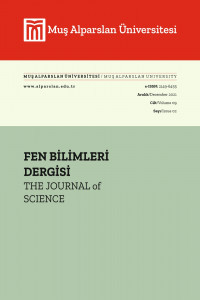Ortam Şartlarının Bir Haptik-Teleoperasyon Sisteminin İki-Yönlü Kontrolü Üzerindeki Etkisi
Haptik-teleoperasyon sistemleri oldukça zorlu ortamlarda görev yapmakta bundan dolayı bu sistemlerin kontrolünde birçok problemlerle karşılaşılmaktadır. Hız ve kuvvet kontrolü doğrusal davranışlar göstermeyen ve zamanla değişen ortam şartları nedeniyle bu sistemlerin kontrolü için zorlu problemlerden biridir. Bu çalışmada gerçek şartlara yakın bir şekilde sistemin kontrolü için hem işlem ve ölçüm hem de ortam gürültüsü eklenerek haptik-teleoperasyon sistemin iki yönlü kontrolü gerçekleştirilmiştir. Tek serbestlik dereceli ana(master) ve bağımlı(slave) robotlardan oluşan sistemin hareket denklemleri elde edilmiştir. Sisteme filtreli ve filtresiz bir şekilde PID kontrol yöntemi uygulanarak performansı kriterlere göre incelenmiştir. Yapılan çalışmalar sonucunda elde edilen sonuçlar incelenmiş ve irdelenmiştir.
Anahtar Kelimeler:
Haptik-Teleoperasyon, Hareket Denklemleri, Ortam Şartları, PID
Effect of Environment Conditions on Bilateral Control of a Haptic-Teleoperation System
Haptic-teleoperation systems work in very tough environments, so many problems are encountered in the control of these systems. Speed and force control are challenging problems for the control of these systems due to the time-varying environmental conditions that do not display linear behavior. In this study, bilateral control of the haptic-teleoperation system was performed by adding both process and measurement and environmental noise to control the system close to real conditions. The equations of motion of the system consisting of a single degree of freedom (master) and slave robots have been obtained. PID control method was applied to the system with and without filter, and its performance was examined according to criteria. The results obtained as a result of the studies conducted were examined and investigated.
Keywords:
Haptic-Teleoperation, Equation of Motion, Environment Conditions, PID,
___
- Katsura S., Iida W., Ohnishi K. Medical mechatronics An application to haptic forceps, Annual Reviews in Control, 29:2 237-245, 2005.
- Lee D., Franchi A., Son H.I., Ha C., Bulthoff H. H., Giordano P. R. Semiautonomous haptic teleoperation control architecture of multiple unmanned aerial vehicles, IEEE/ASME Trans. Mechatronics, 2013.
- Abut T., Soyguder S. Haptic industrial robot control and bilateral teleoperation by using a virtual visual interface, 26th Signal Processing and Communications Applications Conference (SIU). IEEE, 2018.
- Mazerolle S., Breguet J. M., Steinecker A., Agnus J., Perez R., Michler J. Nanomanipulation in a scanning electron microscope, Journal of Materials Processing Technology, 167: 2-3 371- 382, 2005.
- Jiang Z. P., Praly L. Design of robust adaptive controllers for nonlinear systems with dynamic uncertainties, Automatica, 34:7 825-840, 1998.
- Hung N.V.Q., Narikiyo T.,Tuan, H. D. Nonlinear adaptive control of master–slave system in teleoperation, Control Engineering Practice, 11:1 1-10, 2003.
- Cheah C.C., Liu C., Slotine J.J.E. Adaptive tracking control for robots with unknown kinematic and dynamic properties, The International Journal of Robotics Research, 25:3 283-296, 2006.
- Wu Z., Xie X, Shi P. Robust adaptive output‐feedback control for nonlinear systems with output unmodeled dynamics, International Journal of Robust and Nonlinear Control: IFAC‐Affiliated Journal, 18:11 1162-1187, 2008.
- Hosseini-Suny K., Momeni H., Janabi-Sharifi F. Model reference adaptive control design for a teleoperation system with output prediction, Journal of Intelligent Robotic Systems, 59:3-4 319-339, 2010.
- Nuño E., Ortega R., Basañez L. An adaptive controller for nonlinear teleoperators, Automatica, 46:1 155-159, 2010.
- Abut T., Soyguder S. Real-time control of bilateral teleoperation system with adaptive computed torque method, Industrial Robot: An International Journal, 44:3 299-311, 2017.
- Rabah M., Guermah S., Toumii R. Adaptive control of bilateral teleoperation system with compensatory neural-fuzzy controllers, International Journal of Control, Automation and Systems, 15:4 1949-1959, 2017.
- Yang L., Chen Y., Liu Z., Chen K., Zhang Z. Adaptive Fuzzy Control for Teleoperation System with Uncertain Kinematics and Dynamics, International Journal of Control, Automation and Systems, 17:5 1158-1166, 2019.
- García-Valdovinos L. G., Parra-Vega V., Arteaga M. A. Observer-based sliding mode impedance control of bilateral teleoperation under constant unknown time delay. Robotics and Autonomous Systems, 55(8), 609-617,2007.
- Soyguder S., Abut T. Haptic industrial robot control with variable time, Industrial Robot: An International Journal, 43:4 390-402, 2016.
- Abut T., Soyguder S. Real-time control and application with selftuning PID-type fuzzy adaptive controller of an inverted pendulum, Ind.Robot, 46:1 159-170, 2019.
- Hüseyinoğlu M., Abut T. Dynamic Model and Control of 2-Dof Robotic Arm, European Journal of Technique, 8:2 141-150, 2018.
- Abut T., Soyguder S. Interface Design and Performance Analysis for a Haptic Robot, Muş Alparslan Üniversitesi Fen Bilimleri Dergisi, 6:2 553-560, 2018.
- Abut T., Soyguder S. Tek Serbestlik Dereceli Bir Teleoperasyon Sisteminde Kontrol Yöntemlerinin Performans Karşılaştırılması, Fırat Üniversitesi Mühendislik Bilimleri Dergisi, 31:2 507-517, 2019
- Ziegler J.B., Nichols N.B. The classic original paper: Optimum settings for automatic controllers, ASME Transactions, 64. 759-768, 1942.
- ISSN: 2147-7930
- Yayın Aralığı: Yılda 2 Sayı
- Başlangıç: 2013
- Yayıncı: Muş Alparslan Üniversitesi
Sayıdaki Diğer Makaleler
Ortam Şartlarının Bir Haptik-Teleoperasyon Sisteminin İki-Yönlü Kontrolü Üzerindeki Etkisi
Yeni Bir Tahribatsız Muayene Yöntemi: Bakteri Kültürüyle Mikro Hata Tespiti
Hülya DURMUŞ, Bahar Şölen AKDEMİR
Canser GÜL, Sevda ALBAYRAK, Hülya DURMUŞ
Hasan KILIÇ, Hüsnü AKTAŞ, Enver KENDAL, Yunus BAYRAM
Kafes Normlu Riesz Cebirleri Üzerindeki Operatörler İçin Hahn-Banach Teoremi
